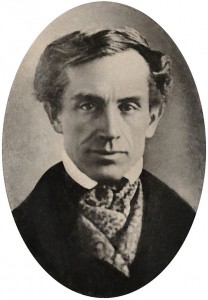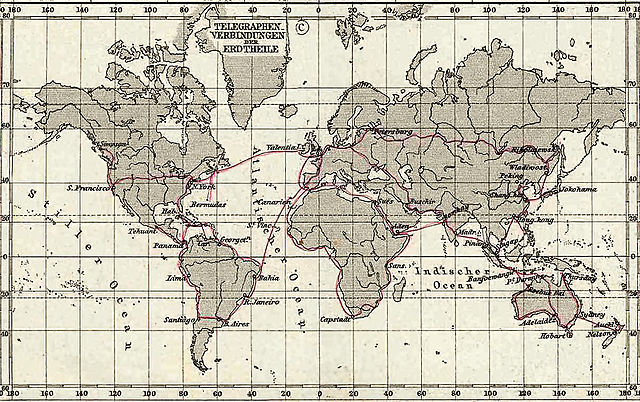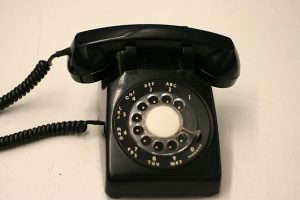On 24 October 1861, Western Union built the first transcontinental telegraph uniting both sides of the country resulting in the speed of communication to be drastically improved. This made a significant impact on how fast important messages of all kinds could be delivered quickly especially when time was critical.

Public Domain(Wikipedia)
In a world with television, telephones, and the Internet, it is hard to imagine not having them. Yet in the past, distance limited how fast important communications could be sent. The speed of the horse, the foot, and how good the wind was would determine how quickly the message was delivered. Samuel Morse on 6 Jan 1838 demonstrated for the first time how electric impulse could transmit messages. He was not the only one who was working on the same concept but the first to get it beyond a concept to a working means of communication.
His prototype demonstrated the use of using dots and dashes to represent letters and numbers. In the demonstration of 1838, he showed that this method of communication was possible. Morse, who had attended Yale University interested in art and electricity, became intrigued when he learned coming home from Europe about the newly discovered electromagnet and decided to work on the telegraph. Convincing skeptics took some doing. Not many were convinced sending messages in this fashion were possible or practical. It required the use of telegraph lines that would transmit the data over long or short distances. And it meant people would have to be trained to understand this Morse code. Morse convinced U.S. Congress to fund construction of the first telegraph line between Washington D.C. and Baltimore, Maryland. The first telegram sent in May 1844 said: “What hath God wrought!”
Soon private companies would emerge using Morse’s patent to set up telegraph lines all over the American Northeast. Western Union, formerly called the New York and Mississippi Valley Company, completed the first transcontinental telegraph line in 1861. Telegraph systems would spread in Europe, Africa, Asia, and Australia. Underwater cables would connect both sides of the Atlantic Ocean. Messages of all kinds could be sent by telegraph. Since telegraph companies charged by the word, messages became succinct no matter whether it was happy or sad news. The period was replaced in most messages with the word “stop” as that was free.

Public Domain (Wikipedia)
One of the chief constraints of the telegraph is that it relied on the telegraph line and undersea cables. Messages could be delayed or lost by downed poles, military actions, weather related issues, or problems in the receiving office. Radio telegraphy was developed by Guglielmo Marconi in 1895. Sending the same messages over the air meant they were no longer restricted to telegraph lines. But it too could have its problems as what happened with Titanic. You have messages get mixed and mashed up resulting inaccurate information being reported. Radio telegraphy would lead to radio transmission allowing voices to be heard for the first time and the radio would be born. Wireless telegraphy would continue for business and governments and develop ultimately into the radioteletype networks.
The old-fashioned telegraph continued. Western Union introduced the singing telegram in 1933 and was still a means of communication until after World War II. During the war the sight of a Western Union courier became dreaded because the War Department sent telegrams to families informing of a death or sometimes a serious injury. The scene in A League of Their Own where Tom Hanks grabs the telegram from the messenger so that he could deliver it was not made up but reflected what most knew telegrams from the War Department would announce.

Photo: R Sull (Wikimedia Commons)
The telephone would ultimately replace the telegraph for most communications. When you could pick up a phone and tell someone important news, there was no need to go down to the Western Union office and pay by the word for a short succinct message when an inexpensive phone call would do it.
Telegraph companies folded up or were bought up by larger companies, or completely rebranded. Today Western Union primarily transfers money (money orders, money transfers, and commercial transactions) and no longer performs any telegraph service. And the old telephone has now been largely replaced by the mobile making them mostly obsolete (though landlines are still needed for critical systems such as emergency alarms and medical emergencies). When you peel back the lens of history and remember there was a time when, if you wanted to send an important message, the telegraph was the fastest option since direct dialing long distances took a while to set up. Today we get upset when the Wi-Fi is down or there is an Internet disruption, and we cannot stream our favorite channel. Just remember that a century ago sending a telegram was the fastest way to get information from one side of the country to the other.
Sources
Mabee, Carleton. “Samuel F.B. Morse | Telegraph, Biography, & Facts.” Encyclopedia Britannica. Last modified October 17, 2024. https://www.britannica.com/biography/Samuel-F-B-Morse.
Morse Code & Telegraph: Invention & Samuel Morse – HISTORY. “Morse Code & Telegraph: Invention & Samuel Morse – HISTORY.” HISTORY, August 12, 2022. https://www.history.com/topics/inventions/telegraph.
Stromberg, Joseph. “How Samuel Morse Got His Big Idea.” Smithsonian Magazine, November 15, 2013. https://www.smithsonianmag.com/smithsonian-institution/how-samuel-morse-got-his-big-idea-16403094/.







